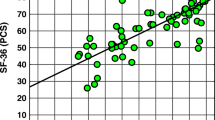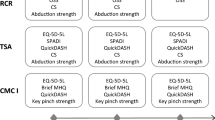Abstract
Purpose
Disease-specific instruments of quality of life (QOL) are more sensitive to disease-specific changes. The purpose of this study is to identify prognostic factors for disease-specific QOL after all-arthroscopic rotator cuff (RC) repair using the Western Ontario Rotator Cuff Index (WORC).
Methods
A total of 140 patients were evaluated after an RC repair with a mean follow-up of 22 ± 6.7 months. Evaluations included the WORC, EQ-5D and anchor questions. Preoperative patient demographics and radiologic characteristics were assessed to identify predictors of disease-specific QOL.
Results
Most patients (81.4 %) were satisfied with their surgical result. Minor tear retraction (odds ratio [OR] 2.97, p = 0.030), male gender (OR 3.67, p = 0.003), no social benefits (OR 3.67, p = 0.042) and pre-surgical complaints for more than six months (OR 3.03, p = 0.021) were independent predictors for superior postoperative WORC score in multivariable analysis. None of these factors were predictive for a higher EQ-5D score.
Conclusion
These findings highlight the important impact of retraction on QOL after RC repair and underline the utility of disease-specific instruments. Future studies should focus on how these significant predictors can be used to improve decision making and to develop new treatment approaches.

Similar content being viewed by others
References
Boileau P, Brassart N, Watkinson DJ, Carles M, Hatzidakis AM, Krishnan SG (2005) Arthroscopic repair of full-thickness tears of the supraspinatus: does the tendon really heal? J Bone Joint Surg Am 87(6):1229–1240. doi:10.2106/JBJS.D.02035
Cho NS, Rhee YG (2009) The factors affecting the clinical outcome and integrity of arthroscopically repaired rotator cuff tears of the shoulder. Clin Orthop Surg 1(2):96–104. doi:10.4055/cios.2009.1.2.96
Chung SW, Oh JH, Gong HS, Kim JY, Kim SH (2011) Factors affecting rotator cuff healing after arthroscopic repair: osteoporosis as one of the independent risk factors. Am J Sports Med 39(10):2099–2107. doi:10.1177/0363546511415659
Chung SW, Park JS, Kim SH, Shin SH, Oh JH (2012) Quality of life after arthroscopic rotator cuff repair: evaluation using SF-36 and an analysis of affecting clinical factors. Am J Sports Med 40(3):631–639. doi:10.1177/0363546511430309
Fermont AJ, Wolterbeek N, Wessel RN, Baeyens JP, de Bie RA (2014) Prognostic factors for successful recovery after arthroscopic rotator cuff repair: a systematic literature review. J Orthop Sports Phys Ther 44(3):153–163. doi:10.2519/jospt.2014.4832
Gulotta LV, Nho SJ, Dodson CC, Adler RS, Altchek DW, MacGillivray JD (2011) Prospective evaluation of arthroscopic rotator cuff repairs at 5 years: part II—prognostic factors for clinical and radiographic outcomes. J Shoulder Elb Surg 20(6):941–946. doi:10.1016/j.jse.2011.03.028
Boissonnault WG, Badke MB, Wooden MJ, Ekedahl S, Fly K (2007) Patient outcome following rehabilitation for rotator cuff repair surgery: the impact of selected medical comorbidities. J Orthop Sports Phys Ther 37(6):312–319. doi:10.2519/jospt.2007.2448
Poolman RW, Swiontkowski MF, Fairbank JC, Schemitsch EH, Sprague S, de Vet HC (2009) Outcome instruments: rationale for their use. J Bone Joint Surg Am 91(Suppl 3):41–49. doi:10.2106/JBJS.H.01551
Kirkley A, Alvarez C, Griffin S (2003) The development and evaluation of a disease-specific quality-of-life questionnaire for disorders of the rotator cuff: the Western Ontario Rotator Cuff Index. Clin J Sport Med 13(2):84–92. doi:10.1097/00042752-200303000-00004
Chung SW, Kim JY, Kim MH, Kim SH, Oh JH (2013) Arthroscopic repair of massive rotator cuff tears: outcome and analysis of factors associated with healing failure or poor postoperative function. Am J Sports Med 41(7):1674–1683. doi:10.1177/0363546513485719
Goutallier D, Postel JM, Bernageau J, Lavau L, Voisin MC (1994) Fatty muscle degeneration in cuff ruptures. Pre- and postoperative evaluation by CT scan. Clin Orthop Relat Res 304:78–83
Slabaugh MA, Friel NA, Karas V, Romeo AA, Verma NN, Cole BJ (2012) Interobserver and intraobserver reliability of the Goutallier classification using magnetic resonance imaging: proposal of a simplified classification system to increase reliability. Am J Sports Med 40(8):1728–1734. doi:10.1177/0363546512452714
Thomazeau H, Boukobza E, Morcet N, Chaperon J, Langlais F (1997) Prediction of rotator cuff repair results by magnetic resonance imaging. Clin Orthop Relat Res 344:275–283
Wessel RN, Lim TE, van Mameren H, de Bie RA (2011) Validation of the Western Ontario Rotator Cuff index in patients with arthroscopic rotator cuff repair: a study protocol. BMC Musculoskelet Disord 12:64. doi:10.1186/1471-2474-12-64
Wessel RN, Wolterbeek N, Fermont AJ, van Mameren H, Sonneveld H, Griffin S, de Bie RA (2013) The conceptually equivalent Dutch version of the Western Ontario Rotator Cuff Index (WORC). BMC Musculoskelet Disord 14(1):362. doi:10.1186/1471-2474-14-362
EuroQol Group (1990) EuroQol—a new facility for the measurement of health-related quality of life. Health Policy 16(3):199–208
Lamers LM, Stalmeier PF, McDonnell J, Krabbe PF, van Busschbach JJ (2005) Measuring the quality of life in economic evaluations: the Dutch EQ-5D tariff. Ned Tijdschr Geneeskd 149(28):1574–1578
de Vet HC, Ostelo RW, Terwee CB, van der Roer N, Knol DL, Beckerman H, Boers M, Bouter LM (2007) Minimally important change determined by a visual method integrating an anchor-based and a distribution-based approach. Qual Life Res 16(1):131–142. doi:10.1007/s11136-006-9109-9
Kim JR, Cho YS, Ryu KJ, Kim JH (2012) Clinical and radiographic outcomes after arthroscopic repair of massive rotator cuff tears using a suture bridge technique: assessment of repair integrity on magnetic resonance imaging. Am J Sports Med 40(4):786–793. doi:10.1177/0363546511434546
Carbonel I, Martinez AA, Calvo A, Ripalda J, Herrera A (2012) Single-row versus double-row arthroscopic repair in the treatment of rotator cuff tears: a prospective randomized clinical study. Int Orthop 36(9):1877–1883. doi:10.1007/s00264-012-1559-9
Lubiatowski P, Kaczmarek P, Dzianach M, Ogrodowicz P, Breborowicz M, Dlugosz J, Lisiewicz E, Romanowski L (2013) Clinical and biomechanical performance of patients with failed rotator cuff repair. Int Orthop 37(12):2395–2401. doi:10.1007/s00264-013-2024-0
Dunbar MJ, Richardson G, Robertsson O (2013) I can’t get no satisfaction after my total knee replacement: rhymes and reasons. Bone Joint J 95-B(11 Suppl A):148–152. doi:10.1302/0301-620X.95B11.32767
Razmjou H, Davis AM, Jaglal SB, Holtby R, Richards RR (2011) Disability and satisfaction after rotator cuff decompression or repair: a sex and gender analysis. BMC Musculoskelet Disord 12:66. doi:10.1186/1471-2474-12-66
McRae S, Leiter J, Walmsley C, Rehsia S, Macdonald P (2011) Relationship between self-reported shoulder function/quality of life, body mass index, and other contributing factors in patients awaiting rotator cuff repair surgery. J Shoulder Elb Surg 20(1):57–61. doi:10.1016/j.jse.2010.06.011
Wu XL, Briggs L, Murrell GA (2012) Intraoperative determinants of rotator cuff repair integrity: an analysis of 500 consecutive repairs. Am J Sports Med 40(12):2771–2776. doi:10.1177/0363546512462677
Nho SJ, Brown BS, Lyman S, Adler RS, Altchek DW, MacGillivray JD (2009) Prospective analysis of arthroscopic rotator cuff repair: prognostic factors affecting clinical and ultrasound outcome. J Shoulder Elb Surg 18(1):13–20. doi:10.1016/j.jse.2008.05.045
Steenbrink F, de Groot JH, Veeger HE, van der Helm FC, Rozing PM (2009) Glenohumeral stability in simulated rotator cuff tears. J Biomech 42(11):1740–1745. doi:10.1016/j.jbiomech.2009.04.011
Acknowledgments
We would like to thank E. Tromp (PhD, Department of statistics, St. Antonius Hospital, Nieuwegein, The Netherlands) for her statistical support. Finally, all analyses were conducted by the authors.
Conflict of interest
The authors declare that they have no competing interests.
Ethical approval
All procedures performed in studies involving human participants were in accordance with the ethical standards of the institutional and/or national research committee and with the 1964 Helsinki declaration and its later amendments or comparable standards.
The institutional medical ethical review board of the St. Antonius Hospital, Nieuwegein, the Netherlands, gave approval for conducting this study (Study number Z-12.34).
Author information
Authors and Affiliations
Corresponding author
Electronic supplementary material
Below is the link to the electronic supplementary material.
Supplement 1
(DOC 57 kb)
Rights and permissions
About this article
Cite this article
Kolk, A., Wolterbeek, N., Auw Yang, K.G. et al. Predictors of disease-specific quality of life after arthroscopic rotator cuff repair. International Orthopaedics (SICOT) 40, 323–329 (2016). https://doi.org/10.1007/s00264-015-2996-z
Received:
Accepted:
Published:
Issue Date:
DOI: https://doi.org/10.1007/s00264-015-2996-z




